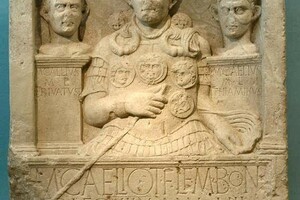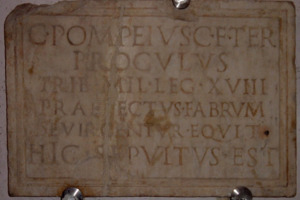Roman Legion - Legio XVIII
Legio XVIII (Eighteenth Legion) was a Roman legion formed by Caesar's successor, Octavian Augustus, in 41 or 40 BCE to fight against the son of Pompey the Great, Sextus Pompey, who had seized the island of Sicily and from there threatened the grain supply routes to Rome, thereby challenging Octavian's authority. In 41 BCE, the armies of both Caesar and Pompey the Great had legions with this number. Most likely, Caesar's 18th Legion perished along with other legions under Gaius Scribonius Curio in Africa, and Pompey's 18th Legion was disbanded after his defeat. There is a version that Octavian's 18th Legion was created from his own legion and the legion with the same number that fought on the side of Mark Antony.
Date of existence: Presumably 41/40 BCE - 9 CE.
Legion Symbol: Unknown.
Titles: Unknown.
Battle Path
- Most scholars agree that Legio XVIII was created by Octavian Augustus in 41 or 40 BCE to fight Sextus Pompey. Between 30 and 14 BCE, veterans of Legio XVIII were settled in the newly established colony of Ateste (present-day Este, in northern Italy). Most likely, the legion was later located in Aquitaine. It was later transferred in 15 BCE to the Rhine. Here, the winter base of Legio XVIII was the city of Vetera (now the city of Xanten, Germany), as well as the city of Oberaden or Haltern (now the city of Haltern am See, Germany). Aquitaine was a Roman province from 22 BCE to the beginning of the 5th century CE. The name comes from the Aquitaine tribe — one of the ancestors of the modern Basques.
- Legio XVIII also took part in the German campaigns of Drusus (13-9 BCE) and Tiberius (8-5 BCE). In 6 CE, Legio XVIII, as part of a large army of 13 legions, took part in Tiberius' military campaign against the Marcomannic king Maroboduus, but the campaign was interrupted by the Great Illyrian Revolt.
- In 9 CE, Legio XVIII, along with Legio XVII and Legio XIX, participated in the unsuccessful military campaign of the German governor Publius Quinctilius Varus, which ended with the destruction of all three legions and the governor himself at the Battle of the Teutoburg Forest. In memory of the legions' fate, their numbers were never reassigned to other legions of the Roman Empire. The lost eagle of Legio XVIII was recovered by the Romans either during the reign of Emperor Tiberius (reigned 14-37) or during the reign of Emperor Caligula (reigned 37-41).
Three men who served in Legio XVIII are known to history:
1. Military Tribune Gaius Pompeius Proculus of Rome
2. Centurion Marcus Caelius, who died in the Battle of Teutoburg, with a monument from his grave kept in a museum in Xanten, Germany.
3. Legionary Titus Atidius Porcion of Ateste
Related topics
List of Roman Legions, Octavian Augustus, Legion, Legionnaire, Octavian Augustus, Legio XVII, Legio XIX
Literature
1. Emil Ritterling. Paulys Realencyclopädie der classischen Altertumswissenschaft. Legio (XVII, XVIII, XIX). Band XII,2. — Stuttgart, 1925. — 1767 p.
2. Matthew Bunson. Encyclopedia of the Roman empire. — Sonlight Christian, 2002.
3. Nico Roymans. From the Sword to the Plough. Three Studies on the Earliest Romanisation of Northern Gaul. — Amsterdam University Press, 1996.
4. Gaius Velleius Paterculus. Roman History // Small Roman Historians, Moscow: Ladomir, 1996, pp. 11-98.
5. Kanya River. A brief history of the various legions. Legio. 2001.
6. Jona Lendering. Legio XVIII (English). Livius.org. 2002.




